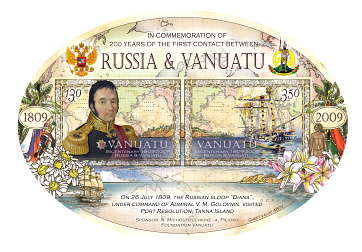Russia-Vanuatu 1809-2009
-
Denominations :130, and 350 vatu. M/S is 480 vatu
-
Designer :Denise Durkin, Wellington, New Zealand
-
Mini Sheet size :128mm x 89mm
-
Paper :104gsm litho gummed stamp paper
-
Period of Sale :28 July 2009 for a period of 2 years
-
Printer :Wyatt and Wilson Printers, Christchurch, New Zealand
-
Process :Offset lithography
-
Stamp Size :50.16 mm x 34.96 mm, two horizontal stamps
Description
On 25 July 1807 the Russian sloop “Diana”
under the command of V.M. Golovnin with a young crew of fifty-five
sailed from Kronstadt, a Russian seaport town in the Gulf of Finland,
to Petropavlovsk-in-Kamchatka in the far east of the country.
Its voyage was one of provisioning to the new Russian settlements in
the Far East and North America as well as of surveying and discovery in
North Pacific waters.

On 26 July 1809 the sloop found itself entering a small bay in the tropical Pacific named by Captain Cook “Port Resolution” and by Tanna islanders – “Uea”, in the dark, volcanic lee of Mount Yasur. “Diana” had no orders to call at Tanna Island - her arrival was a consequence of a dramatic and unlikely series of events, including capture by the British, an escape from Simon's Bay in South Africa, at dusk and in a storm, and an exhausting, uninterrupted passage across the Indian Ocean and Tasman Sea with the intention of avoiding all encounters with the British fleet or British merchantmen in Australian waters. Tanna was chosen by V.M. Golovnin as their resting and revitalizing spot, well removed from normal shipping routes and likely to be free of Europeans, yet supplied with ample fruit, some drinking water, and a neatly charted harbour. 
All, in fact, passed off as well as Golovnin could have desired, after tense initial meetings with a Kwamera-speaking Tannese group led by an elder called Gunama. Drawing maximum advantage from the works of the two Forsters who, had been at Tanna with “Resolution” in 1774, Golovnin proceeded cautiously but amicably. A single day produced, through barter at the water's edge, some forty feet of sugarcane, 400 coconuts or more, and yams. Uea Bay, meanwhile, was surveyed by cutter, and Tannese weaponry and other artifacts were collected and can be now seen at St. Petersburg Kunstcamera Museum. Full notes were taken about the evidence of tribal warfare, social structure, navigation, husbandry and diet, clothing, ornament, and language. “Diana’s” visit to Uea Bay was beneficial in both practical and scientific terms.
This stamp issue marks 200 years since the first Russian-Vanuatu contact, which continues today and will be celebrated on 28 July 2009 in Port Vila.


